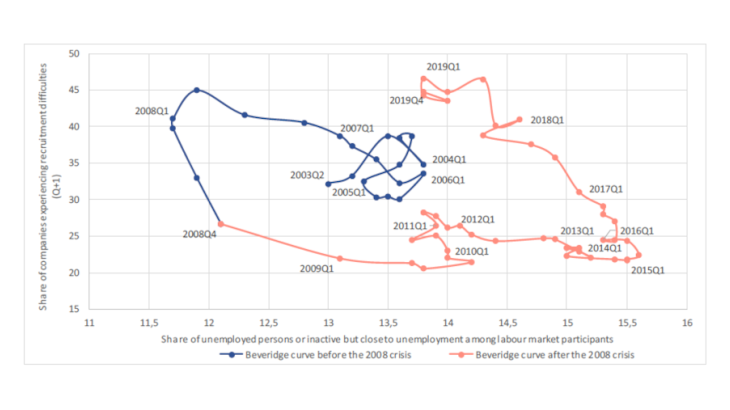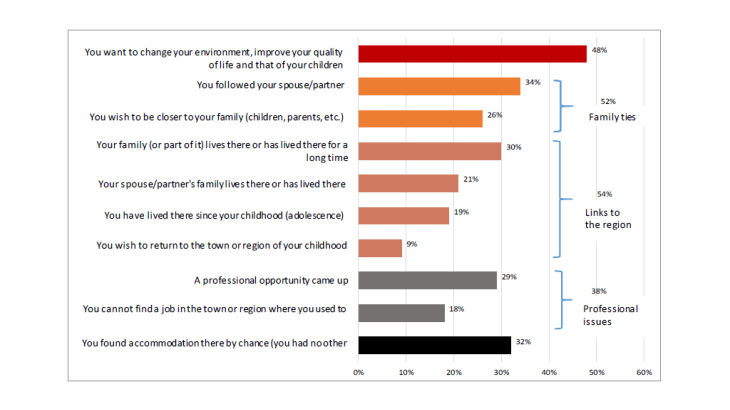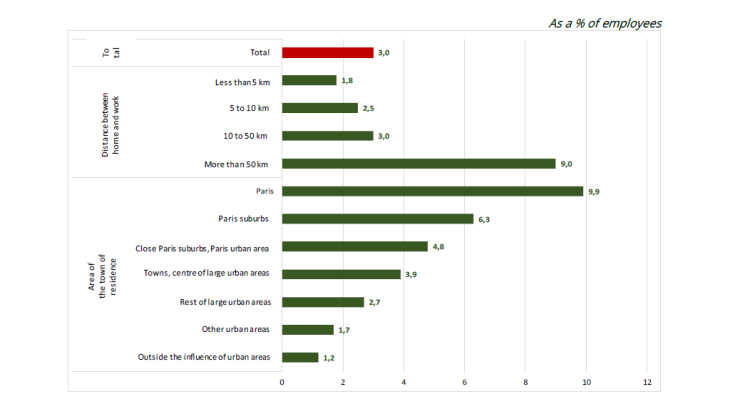- Home
- Publications et statistiques
- Publications
- Teleworking : an opportunity to reduce f...
Teleworking : an opportunity to reduce frictional unemployment
Post n°295. By shortening the number of days spent on-site at their workplace, teleworking can, under certain conditions, broaden job seekers’ geographical search perimeter. By reducing the rigidities linked to geographical mobility, teleworking could thus contribute to lowering frictional unemployment.

Source: DARES according to INSEE, business survey and employment survey
In the third quarter of 2022, 7.3% of the French labour force was unemployed, as defined by the International Labour Office, i.e. 2.3 million people. While unemployment includes a cyclical determinant linked to economic activity, it also includes a so-called "structural" determinant, notably a component known as "frictional unemployment", which is considered a lower limit on the feasible unemployment rate. Frictional unemployment results from the time needed to match job vacancies with job seekers who meet the criteria. The quality of the matching can be represented by the Beveridge curve (see Chart 1). Focusing on the frictional part of unemployment excludes from the scope of analysis all categories of unemployment and the issues related to the general equilibrium of the labour market and productivity.
Geographical location: frictions on the job market, especially for women
In 2021, according to Pôle Emploi’s Besoins en Main-d’Oeuvre survey, recruitment difficulties concerned 46% of establishments that had sought to recruit, i.e. 11.4 percentage points more than in 2020, and 3.5% of establishments had given up hiring because of expected recruitment difficulties. Of the expected recruitment difficulties, 14.7% were linked to geographical considerations. According to a survey carried out by Pôle Emploi, the same holds true for jobseekers: almost one in five considers geographical proximity to be the primary criterion in their search for work. Thus, in a report by the General Inspectorate of Finance, structural unemployment linked to geographical mismatches in France was estimated at between 1 and 2.5 percentage points of the unemployment rate in 2016.
These rigidities linked to the geographical location seem to affect women more, whether by constraint or by choice: 26% of women find a job more than 30 km from their home, compared with 33% for men. Moreover, couples move more often to promote men’s employment: 41% of women say they have chosen their town of residence to follow their spouse/partner, compared with only 26% for men. In the case of dual-income couples, work transfers are more often to the benefit of men (25.9% of men, against 15.1% of women, Dares (2019)) and resignations to the detriment of women (36.4% of women, against 26.0% of men).
Geographical rigidities that are hard to reduce but may be managed by means of transport
Geographical rigidities, created by jobseekers’ reluctance to be geographically mobile, appear to be motivated above all by psychological and social considerations that are difficult to influence by public policies. Among the jobseekers surveyed by Pôle Emploi who were not born in the town where they currently reside, the main determinants of the choice of town of residence are quality of life (48%), family ties (52%) and links to the region (52%), well ahead of professional issues (38%) (cf. Chart 2).

Source: Pôle emploi - 2018 survey of job seekers on their attachment to their region
Links to the region is more than a rigidity related to distance, it appears to be related to the ease of commuting between the jobseeker's home and the job vacancy. Jobseekers were asked whether they would accept a job further away if a “shuttle” could take them to their place of work. Half of the 18% of jobseekers who had not widened their search perimeter, even those in long-term unemployment, said they would do so under this condition.
The geographical search perimeter is widened with the introduction of a shuttle regardless of the characteristics of the jobseekers. However, the effect is stronger among women: the share of women who agree to widen their search perimeter is multiplied by 1.8, compared to 1.5 for men.
Teleworking reduces geographical frictions but is insufficiently and unevenly used
Teleworking is used to reduce employees’ commuting frequency and time: according to the Dares, those who telework live 1.5 times further from their workplace than their colleagues who do not. Recourse to teleworking increases with the distance between home and the workplace: in 2017, 9.0% of employees living more than 50 km from their workplace teleworked, compared with only 1.8% of their colleagues working less than 5 km from home (see Chart 3).

Source: Dares, Réponse 2017 survey, DGT-Dares-DGAFP.
Key: 1.8% of employees living less than 5km from their workplace telework regularly.
By reducing employees’ commuting frequency and time, teleworking lowers the associated costs. When faced with a job offer, an individual takes into account the salary offered net of transport costs (Gobillon, Selod, 2007). Teleworking thus helps to reduce the inconvenience of long commuting times. Since it is not only the distance itself but also the transport-related consequences of commuting that appear to be the main obstacle to jobseekers widening their geographical search perimeter, teleworking therefore appears to be able to lessen some of the geographical rigidities that cause labour market frictions.
However, according to a study by the General Directorate of the French Treasury, recourse to teleworking is currently insufficient and uneven compared to the 30% of jobs that could be done teleworking under good conditions in France. Thus, in 2021, only 6% of employees were intensive teleworkers, the majority of whom were managers (77%) and an over-representation of employees in the IT and telecommunications professions. Women represented only 38% of intensive teleworkers. Their recourse to teleworking is further complicated by family organisational constraints regarding childcare or the availability of a dedicated room (during the lockdown, 25% of women had one, against 41% for men, for further information, see blog post No. 207 by C. Berson).
Teleworking as a tool against unemployment needs to be integrated into matching schemes
It would therefore seem appropriate from the point of view of reducing frictional unemployment to widen the possibilities of teleworking to job vacancies, without restricting them to management level jobs. This can only be done in a context of an overall adaptation of establishments to teleworking, including a sufficiently robust public telecommunication infrastructure across the country.
Recourse to teleworking by jobseekers could also be facilitated, for example by financing part of the costs of home equipment on the same model as existing aids to facilitate geographical mobility, such as Mobilipass for removals or the partial financing of the B driving licence. In addition to the financing of home equipment, jobseekers should also be offered training in teleworking tools and practices. In order to improve matching, we should no longer think in terms of the distance between home and work but in terms of the average daily distance, taking into account the days teleworked as having a zero distance. This indicator could thus replace the distance in the forms filled out by jobseekers and in the offers presented on the Pôle Emploi website.
Given the current societal barriers to women teleworking, even though the issue of the distance between home and work is crucial to them, special attention should be paid to improving women’s access to teleworking. This cannot be achieved without developing efficient childcare facilities across the country.
The winners were selected by an independent jury of experts and researchers. Eco Notepad has allowed all opinions to be expressed as long as they are well-founded. The views expressed in these winning entries are those of the authors and do not in any way reflect the position of the Banque de France or the members of the jury.
Updated on the 25th of July 2024